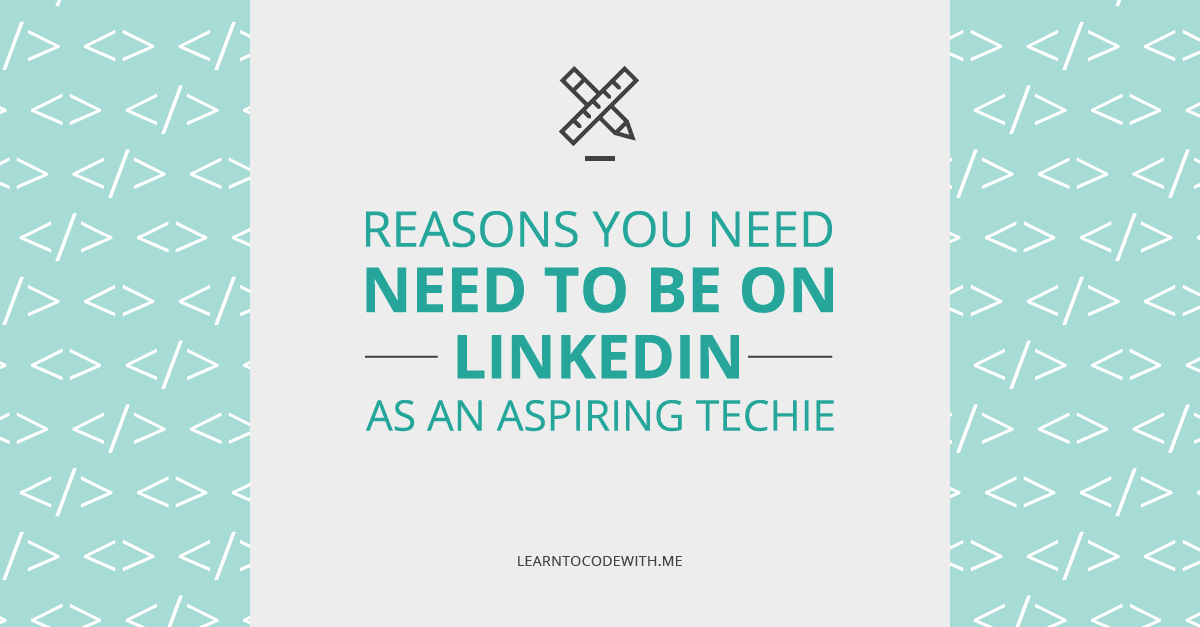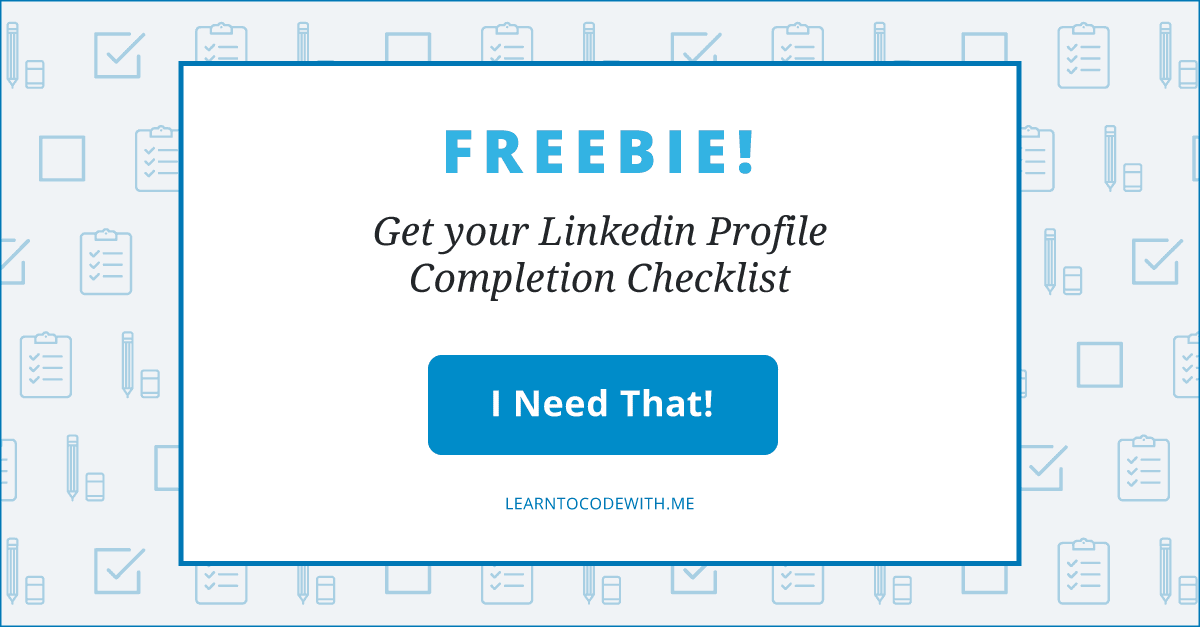You probably already know that you need to be on LinkedIn.
If you’ve been in college, or in the professional world, it’s something you hear all the time, so much so that you may hardly react to it anymore.
Maybe you have a half-done LinkedIn profile, copied and pasted right from your resume. But you haven’t logged in for months.
Or perhaps you don’t have one at all. After all, why bother? You want to freelance. Or maybe you want to run your own business, or startup. In that case, why be on LinkedIn? You don’t want to work for anyone else but yourself, and a LinkedIn profile only matters for those chasing full-time careers at big tech companies…right?
If you are guilty of believing this, today I am going to show you the light and demonstrate why you NEED to be on LinkedIn: whether you’re an aspiring full-time employee, freelancer/consultant, or biz/startup owner.
Checklist download: Download this free checklist that will show you exactly what you need on your LinkedIn profile (as an aspiring techie).
Reason #1: Hiring managers and recruiters are on LinkedIn
Attention full-time job chasers: 94% of recruiters say they use LinkedIn to find candidates. (Some research has found up to 97% of recruiters use LinkedIn.)
Yet the 2014 Jobvite study discovered that while 94% of recruiters are on LinkedIn, only 36% of job seekers are.
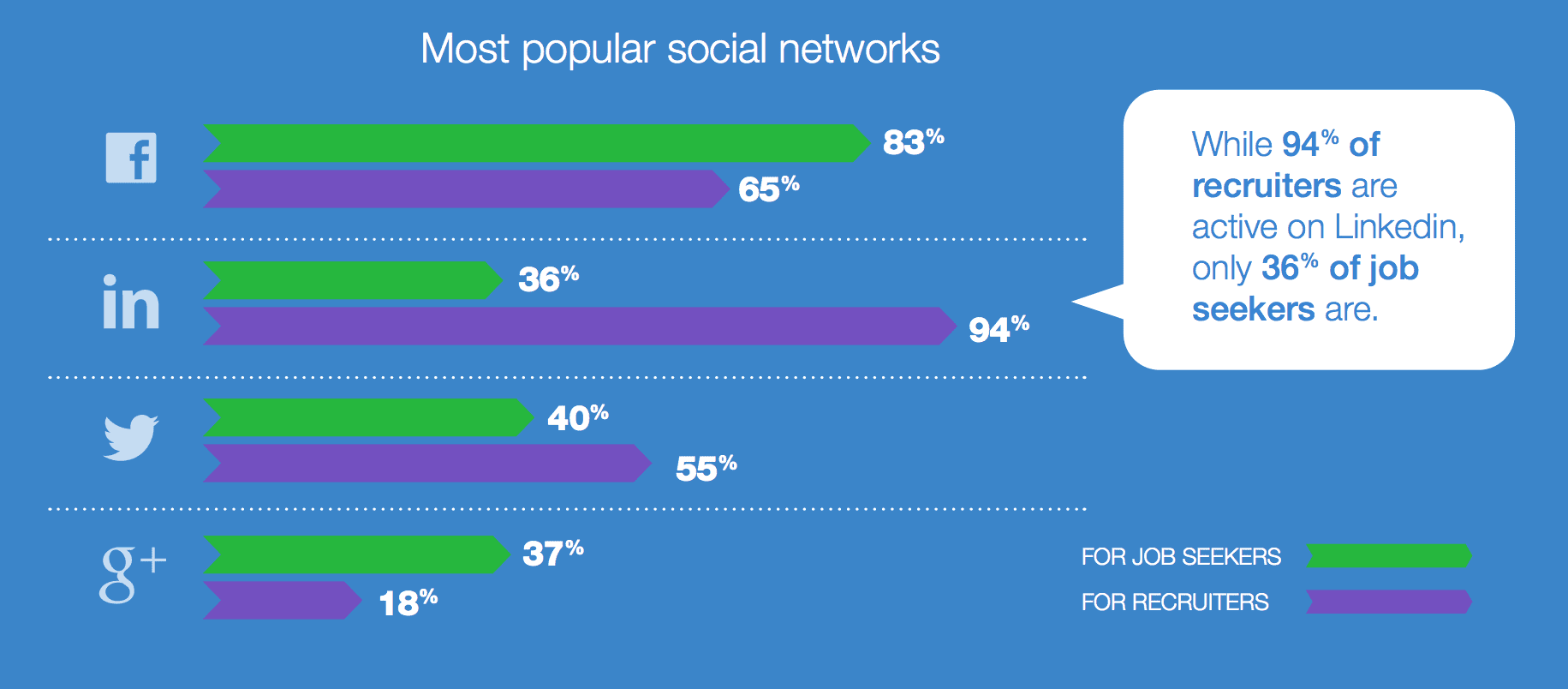
(Hint hint: This is a disparity you can take advantage of!)
Michael Milutis, corporate marketing strategist at CAI and Director and Co-founder of the IT Metrics & Productivity Institute, explains that:
“Any individual who is not on Linkedin in 2016 is akin to a small business that was not in the yellow pages, circa 1980. It’s suicide. Imagine this: what if you showed up for a job interview in the 1980s or 1990s and refused to produce a resume? That’s how decision makers and employers will feel about you if you are not on Linkedin in 2016.”
Yikes.
The takeaway: the people hiring talent are on LinkedIn; you should be, too.
Reason #2: People are no longer getting jobs the old-fashioned way
According to a San Francisco Fed paper highlighted at The Wall Street Journal (paywall), researchers discovered that 75% of those who get new jobs have not been actively looking or even applying to jobs in the last three months. This means one of two things: they were referred, or they were headhunted.
Being referred by a family member or friend is obviously the best way to get a new gig. They are vouching for your ability and intellect, which goes a long way if the hiring manager trusts their opinion.
But what if you don’t have connections at the companies you want to work for? Sure, you can start to form them. (You should be connecting with people in your industry, regardless!)
However, you can also pursue the other option—getting headhunted. And LinkedIn is the social network to be on when it comes to getting discovered for a new professional opportunity.
The takeaway: your chances of landing a job the traditional way are getting slim. Instead, pursue alternative methods.
Reason #3: Recruiters (and hiring managers) use LinkedIn to discover talent
Not only are these people on LinkedIn; they are also using it to discover new talent.
Jenny Foss, career strategist and blogger at JobJenny.com, paints this picture:
“If you’re a professional and not ‘on’ LinkedIn, you nearly don’t exist through the eyes of recruiters. This sounds harsh, but think about it: Tomorrow, a recruiter is going to log into LinkedIn and do a search, say, for a graphic designer with specific knowledge of user experience…within, perhaps, a 25 mile radius of a certain zip code. If you’re a graphic designer with UX knowledge, living in that zip code radius, and interested in landing a new job, guess what happens if you’re not on LinkedIn? Yep, the recruiter finds someone else for a role that may have been very interesting to you.”
This example is precisely why you need to cultivate a LinkedIn presence that will attract people looking to hire YOU.
The good news? If you have a well-made LinkedIn profile as a web developer or related, recruiters will come to you.
Here’s why:
The highest performers, the ones that can make a real difference, aren’t applying to job openings with the masses. Recruiters and hiring managers know this.
They know that these A-players are already gainfully employed at a great organization, likely with great pay, job perks, stock options, and flex schedules.
If they want these high-performers working for them, they need to pry them away. To do that, of course, they need to reach out to them. And the best way to find and contact this “passive talent”—talent who isn’t actively looking for new work, but may be interested—is on LinkedIn. (That’s why companies invest hundreds of thousands of dollars or more into LinkedIn’s Recruiter service.)
Here’s a secret: you don’t actually need to be an “A-player” (yet) to get the attention of recruiters and hiring managers.
But you do need to look like one.
If you want to know what it takes to look like an A-player on LinkedIn, make sure to download my bonus LinkedIn profile checklist.
The takeaway: design your LinkedIn profile to look like an A-player, and you’ll start getting attention.
Reason #4: Your LinkedIn profile helps build trust
Jeremy Schifeling, Founder and CEO at Break into Tech, explains this concept brilliantly: “In the same way that an Uber or Lyft gives you verification about the person who is going to pick you up in the car, you want to know who you’re going to hire or do business with or partner with in a professional context.”
Building trust is important for anyone: full-time career chasers, freelancers, and small business owners alike.
In fact, it may matter even more for the self-employed, as Jeremy points out: “Every time you want to win business, you can bet that [the clients] are going to check you out, look you up and maybe come across your LinkedIn, and so every time they do, the profile is going to work for you.”
The takeaway: your LinkedIn profile is your professional validator. It shows you do indeed exist, and are not too good to be true.
Reason #5: It’s what potential employers and clients will see when they Google your name
If you apply to a job anywhere, there is a 80% chance they will Google your name. (In fact, it’s probably higher now since that research is from 2014.)
And guess what? Your LinkedIn profile will most likely show up first.
Case in point:
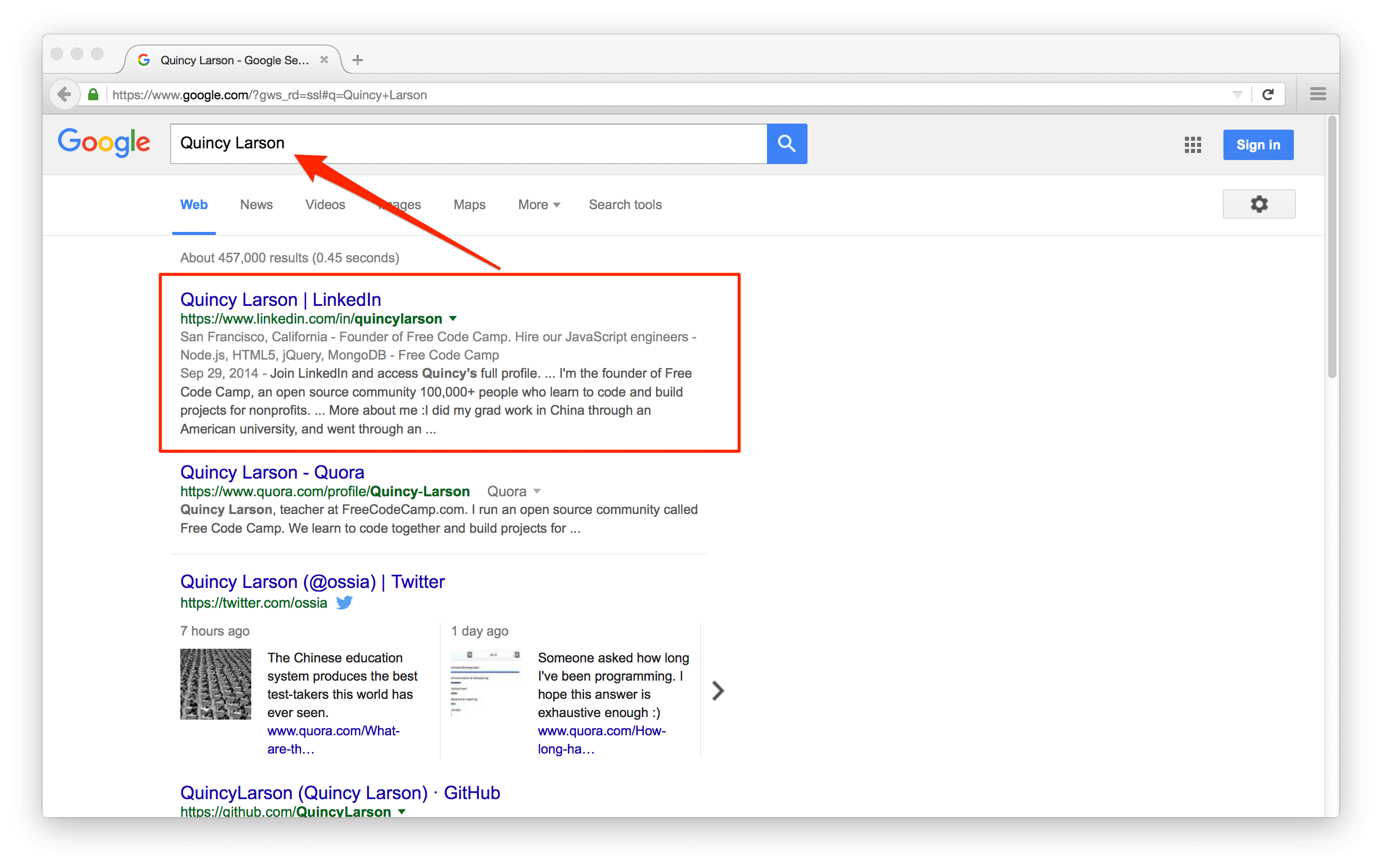
(Yes, even the founder of freeCodeCamp, Quincy Larson, has a LinkedIn profile that shows up as the first result when you Google his name.)
Like it or not, social media accounts make you seem more credible. And unless you’re a celebrity, your LinkedIn profile will appear high-up in search engine results. Probably even first.
Trust me: it’s much better to have your LinkedIn profile show up at the top of Google results rather than your Instagram, Tumblr or other, less professional, social media handles.
The takeaway: hiring managers, potential clients, business acquaintances, etc. will Google your name. And it’s more than likely that your LinkedIn will show up near the top of the results page—which is a good thing if you have a good profile.
Reason #6: Collect endorsements and recommendations
LinkedIn allows you to be endorsed for skills, as well as have bosses and colleagues give you recommendations. (Think of them as testimonials.)
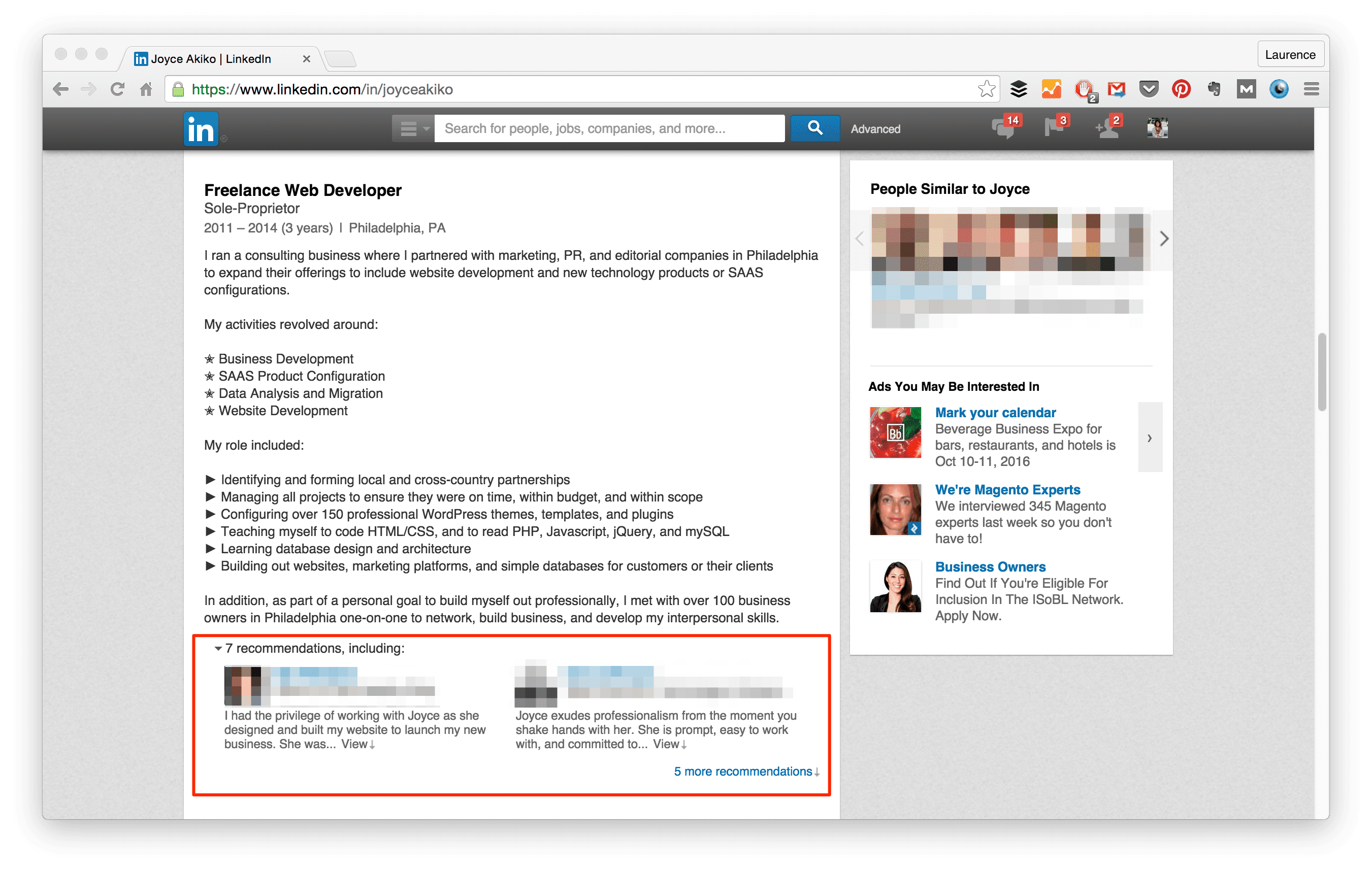
Above, you can see that Joyce Akiko has 7 recommendations along with her freelance web developer work.
Collecting these kinds of praises now is like saving for a rainy day fund.
Even if you’re not currently looking for work, you can use LinkedIn to start collecting recommendations and skill endorsements that may come in handy later.
The takeaway: accumulate praises now that will help later when you are actively looking for new clients and/or full-time opportunities.
Reason #7: LinkedIn is the ultimate personal branding tool
Pay attention, aspiring business owners and startup founders: your personal brand is everything.
“Networking (who you know) and personal branding (what they know about you) always matters, and Linkedin is still currently the best and most widely used tool for managing this,” says Michael Milutis.
Building a strong personal brand now will help you thousands of times over when you have your own business or startup. (Because *you* will be the face of your business!)
Sandy Jones-Kaminski, Founder & Chief Connecting Officer of Bella Domain Media says, “Instead of looking at it as a cut and paste shot from your resume, you have to write your content differently, you have to position yourself, you have to have a compelling, engaging profile that makes people want to find out more about you by them trying to either connect with you or contact you directly.”
Have you ever heard the phrase, “Dress for the job you want, not the job you have”?
The same thing applies to LinkedIn: design it for the clients and jobs you want, not the clients and jobs you already have.
The takeaway: LinkedIn is a cornerstone in your online professional presence; build it for the opportunities you want, not those you already have.
Bonus download: Get this free checklist that will show you *exactly* what you need on your LinkedIn profile.
Reason #8: Cultivate a network now that you can tap into later
Even if you’re happy at your job, you still need a LinkedIn presence. We all know how suddenly things can go awry. And what will you do then?
Fall back on your massive LinkedIn network—that’s what! But if you don’t start building it now, you can’t utilize it when the times are tough.
Again, think of it like saving for an emergency fund. You save now, when things are going well, to be able to use it later…just in case.
Charlyne Fothergill, HR professional and Director of Career Services for Lighthouse Labs, explains, “The power of LinkedIn (and your personal network) is in the 2nd and 3rd connections… you know someone who knows someone.”
With a stacked LinkedIn profile, you’ll be able to ask for introductions from your connections who have connections at the companies you’re dying to work for.
The takeaway: build your LinkedIn network now to fall back on later.
Reason #9: Build stronger relationships and “spy” on companies you want to work for
Met someone at a Meetup or industry event? It’s totally cool to connect with them on LinkedIn afterwards. (In some ways, it’s even expected.)
It helps you two remember each other better following that initial meeting. In fact, according to a (now-unpublished) infographic from Wishpond, 44% of LinkedIn users establish better face-to-face relationships through their use of the platform.
Another advantage of LinkedIn is that you can follow companies. This will allow you to tune into their updates. Company profiles can also show lists of present and former employees…and tell you if you’re connected to any.

You can also find open job positions at the company. And sometimes (like in the picture below), you can see what skills their other current employees have, so you can match them up with your own and see if you’re a good fit.
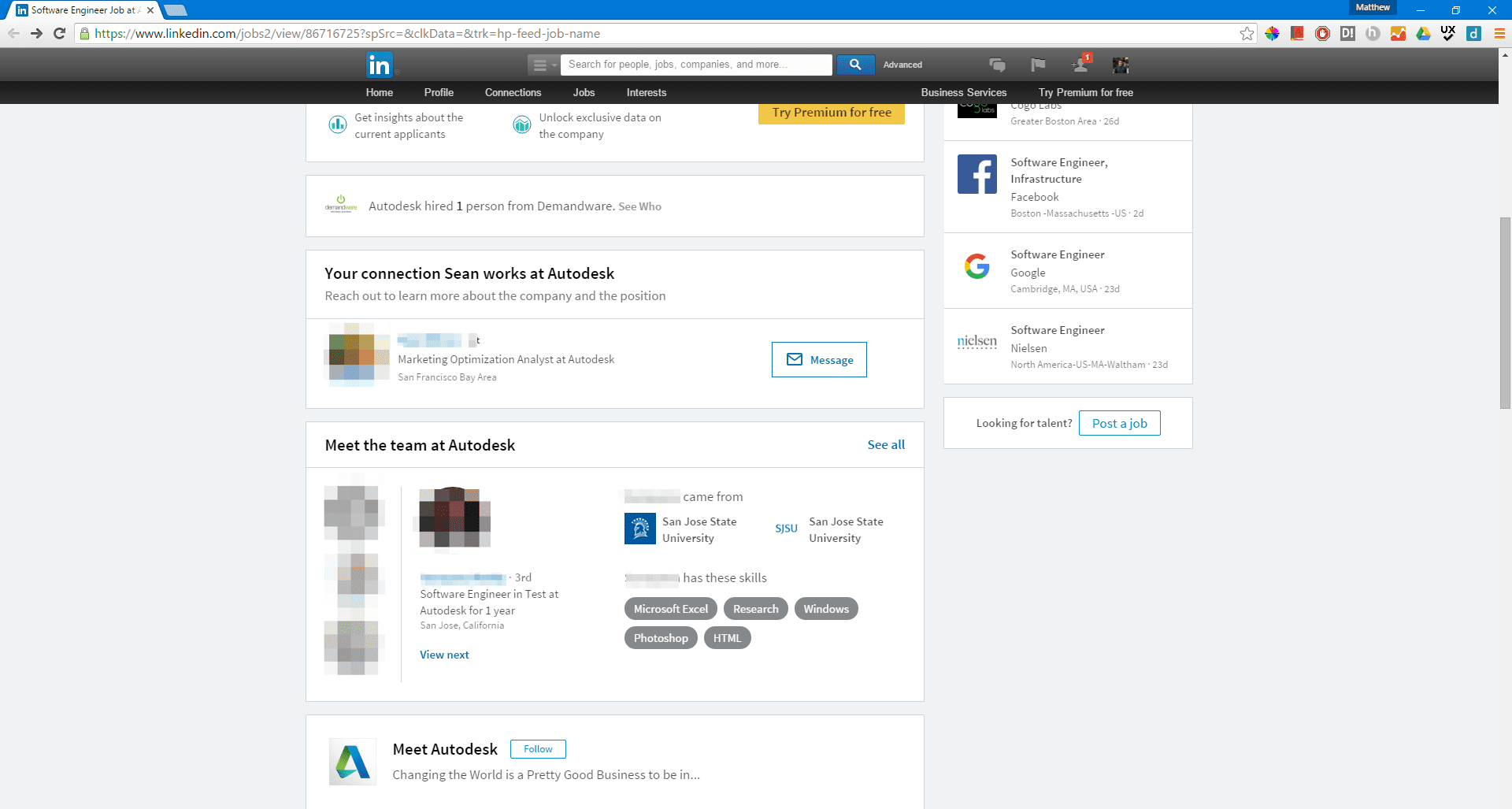
The takeaway: look up the people you meet and the companies you’re interested in. It’s not stalking, it’s research!
Reason #10: Position yourself as an expert on LinkedIn Pulse
Want to start a blog, but don’t have time? Pulse may be a solution. Pulse is also a great alternative for those who aren’t ready to commit to a full-on blog. If you need a point of comparison, think of it like Medium.
Anyone with a LinkedIn profile can publish posts. As of March 2015, more than a million long-form articles had been published, with about 50,000 new ones being published every week (source).
Here’s why it matters to you:
- It’s a chance to share your expertise (without starting a “real” blog)
- An opportunity to connect with people outside your existing network
With the publishing capabilities of Pulse, you can get in front of new audiences.
Publishing on Pulse is one thing, but getting in the “featured” category is even better. In this case study, Marko Saric’s post was featured on Pulse right next to Richard Branson of Virgin. To date his post had attracted over 21,000 views, over 950 likes and more than 2,000 social media shares.
Sure, the 21,000 views happened on his article on Pulse, as opposed to his profile or personal website. But that’s still massive name exposure. And it can lead people to check you out elsewhere on the web.
Case in point: Rachel Foster was able to generate 200+ new email subscribers on her own website after publishing this Pulse article. (Considering she only had about 1,000 LinkedIn connections when she published the piece, that is very good.)
The takeaway: you can get in front of industry leaders by publishing on LinkedIn.
Reason #11: LinkedIn is the most effective social media platform for gaining website traffic and leads
If you’re interested in generating website traffic (cough—bloggers, aspiring biz owners, startup founders—cough), LinkedIn is more effective than other social media sources.
LinkedIn is responsible for a shocking 64% of all visits from social media channels to corporate websites.
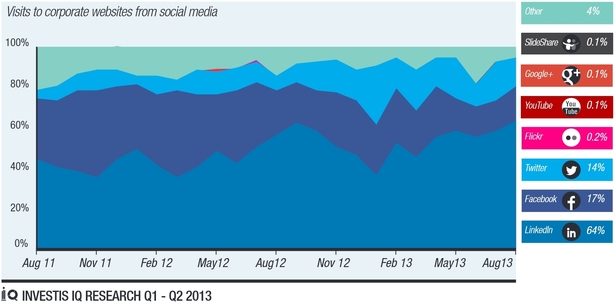
Aside from bringing heaps of website traffic, LinkedIn is also “responsible for more than 80% of a business’s social media leads. All the other social media platforms put together only amount to 19.67% of leads” according to Kissmetrics.
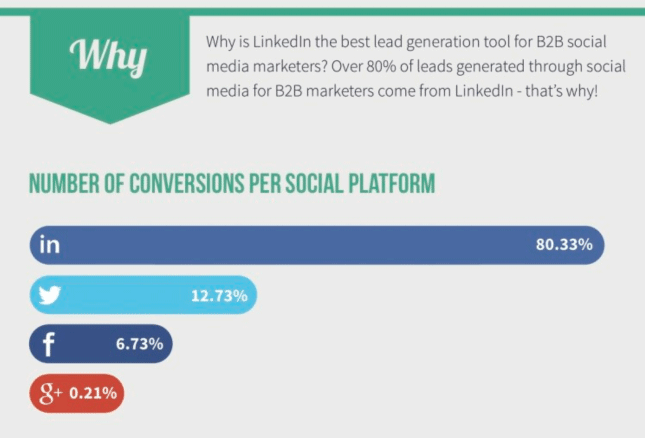
Here’s why LinkedIn is such an effective lead generation tool: LinkedIn members are trying to learn about their industry, build their personal brand, or improve their career (or even all three). They are professionals (or at least portraying themselves as professionals on the site!).
Because of the professional user base, less “clutter” is generally posted. (Clutter = Buzzfeed listicles, cat videos, etc.) With less clutter, a person is capable of consuming a higher percentage of content at any given time.
But what does this mean for you, an aspiring web developer or designer?
It’s simple: it means it’s easier to get noticed in a newsfeed.
This means that regardless of what you do (or hope to do), LinkedIn can be a great channel for marketing yourself.
The takeaway: less clutter → more likely to get noticed → increased website traffic → generate new business leads
Here’s what I want you to do next
I just showed you the tremendous power of LinkedIn when it comes to finding a new career, or new clients, as a web developer/designer.
But for you to get any value from this post, you need to take action.
To make it easier for you, I created a free checklist that outlines EXACTLY what you need to include on your LinkedIn profile as a new techie.
Click the image below to download it!

